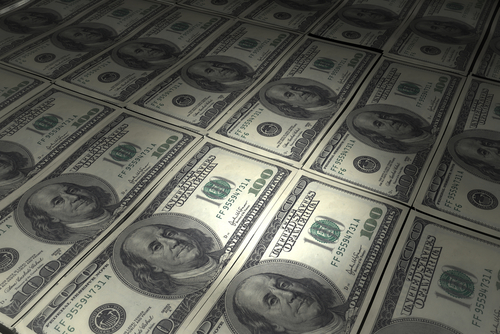I'm in the Mood for Cash
“Cash is king,” was once the old saw. The saying became passé in boomtime. Nobody wanted to hold on to cash. There were stocks and real estate to buy, not to mention big screen TVs and granite counter tops. Besides, the PhDs at Federal Reserve stay up late at night figuring out how to make money less valuable. Ben Bernanke and his colleagues keep printing the stuff to solve what they fear the most: insufficient aggregate demand and liquidity traps.
But for all of the Fed’s stimulus and the central bank’s desire to nudge people and businesses out of cash and into riskier assets, the cash hoards still pile up.
The Economist reported last November that companies have been supplying cash rather than using it since 2008. Firms in the S&P 500 are holding close to a trillion dollars in cash on their collective balance sheets, an increase of 40% from the dark days of 2008.
President Obama has businesses scared to death of investing. Instead cash is sloshing around in banks around the globe. In fact, banks themselves are swimming in liquidity. The loan-to-deposit ratio of America’s banks is a decades-low 70%. Plus, banks still have nearly $1.5 trillion parked at the central bank in excess reserves.
You can get a sense of the significance by looking at the Fed’s data on money velocity. It serves as a measure of how quickly money moves. Lower velocity means higher demand for holding on to the stuff.

This cash hoarding is a worldwide phenomenon. Companies in Japan have increased their liquid assets by 75% since 2007 to $2.8 trillion. Canadian firms have $300 billion sitting on their balance sheets, a 25% increase from 2008.
When he was a governor for the Bank of Canada, Mark Carney told those companies to “put money to work and if they can’t think of what to do with it, they should give it back to their shareholders.”
What’s enticing companies to leave so much money sitting around in demand deposit accounts, money market funds, or treasuries? Usually you might say that they earn more interest this way. But not so. Interest rates have never been lower. Lower rates would seem to discourage cash hoarding.
Banks were hungry for money during the boom. Today, they are doing all they can to get rid of deposits. The central bank’s zero interest rate policy has compressed interest rate margins at banks. Banks can’t pay less than zero for demand deposits, so as lending rates and treasury rates have decreased, interest rate margins have been flattened.
The fact is loan demand is still not up to boomtime levels, and, “The response has been to eliminate some unprofitable deposits,” writes business reporter Jeff Blumenthal, “effectively showing certain customers the door by adding fees or increasing pricing on certain products.”
Still the deposits pile up. At the end of 2008, the total amount in loans and leases in America’s banks stood at $7.9 trillion. Four years later that total stood at $7.7 trillion. The total of Commercial and Industrial loans hasn’t grown at all, standing at $1.5 trillion at the end of 2008 and 2012.
Meanwhile deposits at federally insured institutions have grown from $9 trillion at year end 2008 to $10.8 trillion at the end of last year.
In his book Conquer The Crash, Robert Prechter explains that while the Fed may have an agenda to stimulate, “the ultimate success of the Fed’s attempts to influence the total amount of credit outstanding depends not only upon willing borrowers but also upon the banks as willing lenders.”
It’s not just Keynesians like Ben Bernanke who think low rates equal animal spirits. Followers of the Austrian Business Cycle Theory claim that interest rates set below the natural rate tempts entrepreneurs into investing in higher order goods. These are goods involved in production, say land and factories, rather than consumption goods.
As the Austrian story goes, these lower rates fool entrepreneurs into believing that consumers are saving, thus pushing down interest rates, instead of spending their money on consumer goods. Entrepreneurs start projects that are more “roundabout” and ultimately won’t be completed because the resources won’t ultimately exist to complete them.
Another effect of artificially lowered rates is the distortion of the appreciation of risk. According to Tyler Cowan, Interest rates forced below the natural rate will lead businessmen to make risky investments (defined as “long-term, costly to reverse, high-yielding, and having returns highly sensitive to the arrival of future information”), that leads to clusters of entrepreneurial error.
The Fed is desperate for businesses to make investments and hire people, whether they result in entrepreneurial errors or not. The stated plan is to lower borrowing costs for businesses so that borrowers will seek and be granted loans to do projects that require increased hiring.
However, the results have been terrible. The headline unemployment rate still hovers near 8%. Three million fewer Americans are employed now than in January 2008. Median household income has dropped 9% since the end of 2007. GDP growth since 2007 has been just over half a percent annually.
Here we are four plus years after the financial crisis and businesses are still building or at least holding onto precautionary assets. The Federal Reserve has done most everything in its power to ignite the animal spirits that would make businesses let loose of their reserve assets and put them to work more productively.
While the Fed can create money and lower interest rates, it can’t change social attitudes. With 100 years of central banking under its belt, those operating the Federal Reserve give the impression that its PhDs can set this interest rate or create that amount of money and fix whatever ails the economy by spurring lending, borrowing, and in turn hiring. However, as Prechter reminds us, bullishness for lending and borrowing “cannot be set by decree.”
Leave Wall Street and talk to people on Main Street, and you quickly learn that consumer sentiment is dismal. College graduates are underemployed or can’t find any jobs. There are as many as 20 million homeowners that are still underwater on their homes. A record number of people buy their groceries courtesy of food stamps.
The negative psychology has created an extraordinary demand for liquidity, as evidenced by decades-low money velocity.
The wariness of business to invest and instead hoard cash is a reflection of this negative mood. Try as he might, Ben Bernanke can’t do anything about it.
The monetary authorities may have the will, but the negative social mood holds the sway. It’s the market’s way of thumbing its nose at the great and powerful.



Comments: